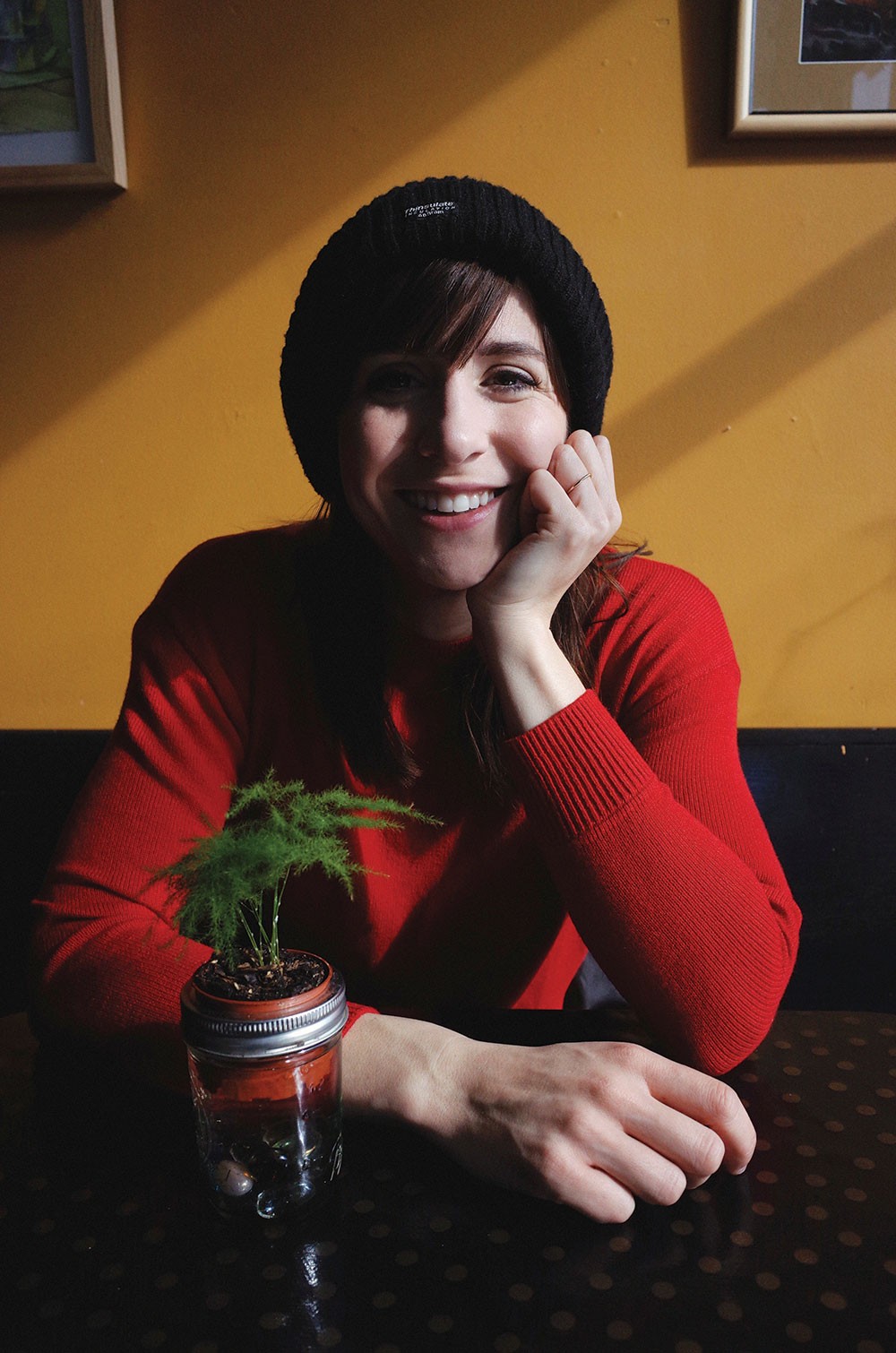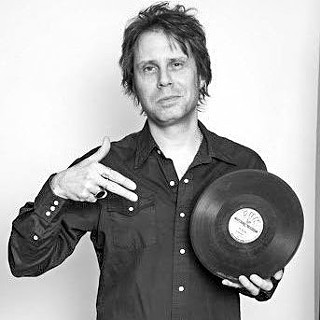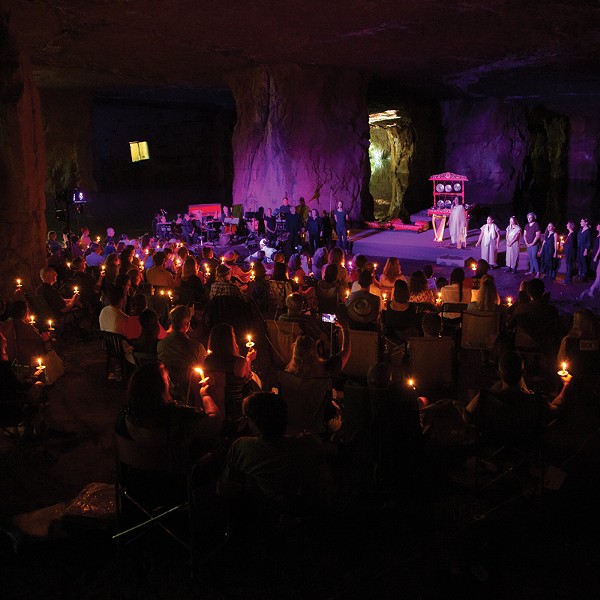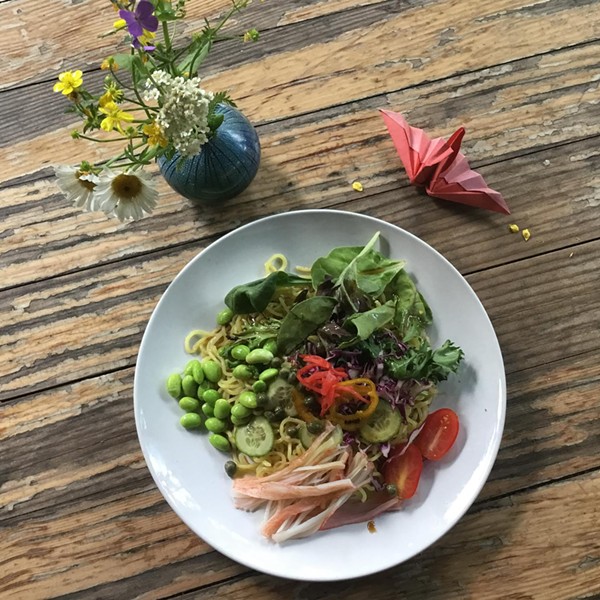It's certainly not unheard of for the offspring of celebrated professional musicians to follow in their parents' footsteps. A few famous instances that come to mind include Sean and Julian Lennon, Justin Townes Earle, John Pizzarelli, and—OMG—Miley Cyrus. But sometimes the serious musical gene skips a generation. Such is the case with with rising indie rocker Laura Stevenson, whose maternal grandfather, pianist and arranger Harry Simeone, led the Harry Simeone Chorale, which recorded the enduring holiday hits "The Little Drummer Boy" (1958) and "Do You Hear What I Hear?" (1962); Simeone's wife (Stevenson's grandmother), Margaret McCrae, aka Margaret McCravy, sang with swing-era band leaders Benny Goodman and Fred Waring. "They divorced and ended up remarrying when they were both in their 80s—they went through some tough times, but they were always in love," Stevenson says. "My grandfather was this very serious, stern person. He'd try to get me to play for him, and I'd be a little afraid. His parents were Italian immigrants and he was from Newark, so he had a really different upbringing than I did."
Stevenson's upbringing happened in Nassau County, Long Island, where her mother, a dental ceramist and casual pianist, played Chopin and show tunes on the stereo; her father, a maritime broker, was a rock fan who passed down his extra Beatles, Neil Young, and Led Zeppelin records to his two daughters. "My parents separated when my sister and I were really young, and my dad lived on a houseboat," says the singer-songwriter, who took piano lessons from her grandmother. "He got me a guitar when I was 15, but I didn't really start to play it until I was 17." In high school, the shy, bookish Stevenson found her tribe in Long Island's youthful and famously hopping ska scene. "It was crazy and goofy, and it was really accessible," she remembers. "It definitely wasn't 'cool' in the usual sense—it was this very nerdy scene that was full of socially awkward misfits where it was easy to be yourself. So it was perfect for me."
One of the big local draws was the six-piece ska punk outfit the Arrogant Sons of Bitches. Led by front man Jeff Rosenstock, the band was a formative inspiration for Stevenson, who could consistently be found skanking it up at their gigs. When the ASOBs broke up in 2005, Rosenstock didn't have to look farther than the front of the stage to find the keyboardist for his next project, Bomb the Music Industry!. With the collective, Stevenson toured the US and made several recordings between working toward a master's degree in art history at Queens College. While in school she also began earnestly writing her own songs, which were largely more reflective and worlds away from the boisterous material of Rosenstock's group. "I was listening to indie rock stuff like Built to Spill and Weezer, but I'd also discovered Leonard Cohen and Elliott Smith," she says. "One of the first songs I wrote was about my best friend, who was in a difficult spot and needed a little moral support. I remember being really nervous when I played it for her—I wouldn't let her look at me when I was singing! [Laughs.]"
The introspective influence of tender brooders Cohen and Smith is predominant on A Record, the 2010 debut by Laura Stevenson and the Cans, although the album is nevertheless leavened by the occasional scrappy pop punk eruption. "I didn't think I was gonna start my own band— Mike [Campbell, her bassist and husband] pushed me into it," recalls Stevenson, who toured on the release in North America and Europe for much of that year. Even further afield from the brassy blare of Bomb the Music Industry! are the songs on 2011's Sit Resist, which feature a country element not often identified with her native Long Island. "I had my Gram Parsons phase, like most singer-songwriters do these days, I guess," says Stevenson. "My dad also had some Flying Burrito Brothers records, so I'd actually heard [Parsons] when I was younger. There's such a tragic-romantic story with him, which of course really attracted me. And even though his voice isn't perfect, it's still beautiful, which was something I identified with."
While there can be no doubt as to the heart-melting majesty of Parsons's vocals, such inward-looking critique is perplexing to hear from Stevenson, whose own soaring voice and achingly melodic songwriting style are gifts many of her peers would die for. But, then again, personal doubt is an essential part of any worthwhile artist's existence, and so it has been with Stevenson, whose art is peppered with palpable self-deprecation. "I have a tendency toward being emotionally overwrought, I think," she says with characteristic humility. "I'm a little bit of a people pleaser—I find myself a lot of the time trying to make people happy. There's a general sunniness in the sound of a lot of my songs, but it tends to leave me a little exhausted."
Stevenson kicked the Cans moniker aside ("It was funny at first, but it didn't feel right anymore") for 2013's Wheel, which rolls between the folk/country vibe that reigned on her earlier efforts and her subsequent rock-leaning direction. The making of the album, which was done with producer Kevin McMahon (Swans, Titus Andronicus) at Marcata Recording in Gardiner, also marked the beginning of the singer and her band's love affair with the Hudson Valley. "I'd visited the area before, but I'd never really spent that much time here," says Stevenson. "I was living in Brooklyn in an apartment with no windows, and I was becoming a hermit because just going out anywhere had gotten to be too insane. Mike and I started coming up just to decompress, then the whole band rented a house on Main Street in Rosendale. That was fun, but also pretty crazy. When Mike and I got engaged we decided we needed our own space and moved up the street. Alex Billig, our accordion and trumpet player, recently bought a house in Kingston and our guitarist, Peter Nadeo, lives in Saugerties. And now Mike and I are looking to buy a place."
The former cement-mining town of Rosendale is where Stevenson struck the mother lode of material that forms the foundation of her latest album, 2015's Cocksure. Produced by her old friend Jeff Rosenstock, it's the first record to feature her band's new drummer, the formidable former Frankie and His Fingers pounder Samantha Niss, and is easily Stevenson's most rocking disc to date. "Laura's a genius as songwriter," Rosenstock enthuses. "There's a lot going on in her songs lyrically, but it's never what I'd call overpowering. To me, it's clear that when you listen to her records you're listening to someone who really loves music and knows how to write great songs." Fruitfully pitting the leader's lilting vocal against crashing electric guitars, the set is laden with such irresistibly crunchy, ear-worming pop gems as "Torch Song" and the single "Jellyfish," whose lyrics harken back to Stevenson's hermetic Brooklyn garret: "Blaming everyone but myself / I'll be home indoors / because I'm wasting away my life and gifts on being a jellyfish."
But, on the heels of Cocksure, holing up and hiding out is exactly not what Stevenson has been doing. Since its release, she's been touring like a demon, both with her full electric band and in an acoustic duo with Campbell (a digital-only live album recorded at the legendary Vera Club in Groningen, Holland, was released last year on Rosenstock's Quote Unquote label, with 100 percent of its sales proceeds going to Planned Parenthood). "Lately, off the road, I've been writing songs really consistently," says Stevenson, who over her still-unfolding career has shared stages with the likes of the Gaslight Anthem, the Go-Go's, and Against Me! and at the time of this interview was prepping to perform in Australia and again across the US. "But I don't ever seek songs out. I've learned just to go with whatever's happening."
Somewhere, stern, old Harry Simeone has lightened up—and he's smiling. In that way that only a proud grandpa would smile.
Stevenson will be performing at BSP Kingston on March 31.

















